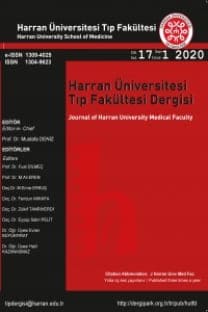Çoklu İntrakraniyal Anevrizmalarda Prognozda Etkili Faktörler
subaraknoid kanama, çoklu intrakraniyal anevrizma, WFNS skoru, Fisher skoru, GOS skoru
Factors Affecting on the Prognosis in Multiple Intracranial Aneurysms
___
- 1. Ellamushi HE, Grieve JP, Jager HR, Kitchen ND. Risk factors for the formation of multiple intracranial aneurysms. J Neurosurg. 2001;94(5):728-32.
- 2. Rinne J, Hernesniemi J, Puranen M, Saari T. Multiple intracranial aneurysms in a defined population: prospective angiographic and clinical study. Neurosurgery. 1994;35(5):803-8.
- 3. Jabbarli R, Dinger TF, Darkwah Oppong M, Pierscianek D, Dammann P, Wrede KH, et al. Risk Factors for and Clinical Consequences of Multiple Intracranial Aneurysms: A Systematic Review and Meta-Analysis. Stroke. 2018;49(4):848-55.
- 4. Kassell NF, Torner JC, Jane JA, Haley EC, Jr., Adams HP. The International Cooperative Study on the Timing of Aneurysm Surgery. Part 2: Surgical results. J Neurosurg. 1990;73(1):37-47.
- 5. Mizoi K, Suzuki J, Yoshimoto T. Surgical treatment of multiple aneurysms. Review of experience with 372 cases. Acta Neurochir (Wien). 1989;96(1-2):8-14.
- 6. Rinne J, Hernesniemi J, Niskanen M, Vapalahti M. Management outcome for multiple intracranial aneurysms. Neurosurgery. 1995;36(1):31-7; discussion 7-8.
- 7. Yaşargil MG. Multiple Aneurysms. In: Yaşargil MG, editor. Microneurosurgery: II Clinical Considerations, Surgery of the intracranial aneurysms and results. 2. Stuttgart: George Thieme Verlag; 1984. p. 305-28.
- 8. Yaşargil MG. Pathological Considerations. In: Yaşargil MG, editor. Microneurosurgery: I Microsurgical Anatomy of the Basal Cisterns and Vessels of the Brain; Diagnostic Studies, General Operative Techniques and Pathological Considerations of the Intracranial Aneurysms. 1. Stuttgart: George Thieme Verlag; 1984. p. 279-349.
- 9. Juvela S. Risk factors for multiple intracranial aneurysms. Stroke. 2000;31(2):392-7.
- 10. Inagawa T. Multiple intracranial aneurysms in elderly patients. Acta Neurochir (Wien). 1990;106(3-4):119-26.
- 11. Kaminogo M, Yonekura M, Shibata S. Incidence and outcome of multiple intracranial aneurysms in a defined population. Stroke. 2003;34(1):16-21.
- 12. Wachter D, Kreitschmann-Andermahr I, Gilsbach JM, Rohde V. Early surgery of multiple versus single aneurysms after subarachnoid hemorrhage: an increased risk for cerebral vasospasm? J Neurosurg. 2011;114(4):935-41.
- 13. Oh K, Lim YC. Single-session Coil Embolization of Multiple Intracranial Aneurysms. J Cerebrovasc Endovasc Neurosurg. 2013;15(3):184-90.
- 14. Defillo A, Qureshi M, Nussbaum ES. Are Multiple Intracranial Aneurysms, More Than 5 At One Time, Almost Exclusively A Female Disease? A Clinical Series and Literature Review. J Neurol Stroke. 2014;1(4).
- 15. Inagawa T. Surgical treatment of multiple intracranial aneurysms. Acta Neurochir (Wien). 1991;108(1-2):22-9.
- 16. Nehls DG, Flom RA, Carter LP, Spetzler RF. Multiple intracranial aneurysms: determining the site of rupture. J Neurosurg. 1985;63(3):342-8.
- 17. Fogelholm R, Hernesniemi J, Vapalahti M. Impact of early surgery on outcome after aneurysmal subarachnoid hemorrhage. A population-based study. Stroke. 1993;24(11):1649-54.
- 18. Wang R, Zhang D, Zhao J, Wang S, Zhao Y, Niu H. A comparative study of 43 patients with mirror-like intracranial aneurysms: risk factors, treatment, and prognosis. Neuropsychiatr Dis Treat. 2014;10:2231-7.
- 19. Kassell NF, Torner JC, Haley EC, Jr., Jane JA, Adams HP, Kongable GL. The International Cooperative Study on the Timing of Aneurysms Surgery. Part I: Overall management results. J Neurosurg. 1990;73:18-37.
- 20. Schievink WI. Genetics of intracranial aneurysms. Neurosurgery. 1997;40(4):651-62; discussion 62-3.
- 21. Jiang H, Weng YX, Zhu Y, Shen J, Pan JW, Zhan RY. Patient and aneurysm characteristics associated with rupture risk of multiple intracranial aneurysms in the anterior circulation system. Acta Neurochir (Wien). 2016;158(7):1367-75.
- 22. Sheehan JP, Polin RS, Sheehan JM, Baskaya MK, Kassell NF. Factors associated with hydrocephalus after aneurysmal subarachnoid hemorrhage. Neurosurgery. 1999;45(5):1120-7; discussion 7-8.
- 23. Tomlinson BE. Ischaemic lesions of the cerebral hemispheres following rupture of intracranial aneurysms. 1. Descriptions of the ischaemic lesions. Newcastle Med J. 1966;29:81-4.
- 24. Solomon RA, Onesti ST, Klebanoff L. Relationship between the timing of aneurysm surgery and the development of delayed cerebral ischemia. J Neurosurg. 1991;75(1):56-61.
- 25. Inagawa T. Effect of early operation on cerebral vasospasm. Surg Neurol. 1990;33(4):239-46.
- 26. Rosengart AJ, Schultheiss KE, Tolentino J, Macdonald RL. Prognostic factors for outcome in patients with aneurysmal subarachnoid hemorrhage. Stroke. 2007;38(8):2315-21.
- 27. Weyhenmeyer J, Guandique CF, Leibold A, Lehnert S, Parish J, Han W, et al. Effects of distance and transport method on intervention and mortality in aneurysmal subarachnoid hemorrhage. J Neurosurg. 2018;128(2):490-8.
- 28. Lanzino G, Kassell NF, Germanson TP, Kongable GL, Truskowski LL, Torner JC, et al. Age and outcome after aneurysmal subarachnoid hemorrhage: why do older patients fare worse? J Neurosurg. 1996;85(3):410-8.
- 29. Tapaninaho A, Hernesniemi J, Vapalahti M, Niskanen M, Kari A, Luukkonen M, et al. Shunt-dependent hydrocephalus after subarachnoid haemorrhage and aneurysm surgery: timing of surgery is not a risk factor. Acta Neurochir (Wien). 1993;123(3-4):118-24.
- 30. Fisher CM, Kistler JP, Davis JM. Relation of cerebral vasospasm to subarachnoid hemorrhage visualized by computerized tomographic scanning. Neurosurgery. 1980;6(1):1-9.
- 31. Harrod CG, Bendok BR, Batjer HH. Prediction of cerebral vasospasm in patients presenting with aneurysmal subarachnoid hemorrhage: a review. Neurosurgery. 2005;56(4):633-54; discussion -54.
- ISSN: 1304-9623
- Yayın Aralığı: 3
- Başlangıç: 2004
- Yayıncı: Harran Üniversitesi Tıp Fakültesi Dekanlığı
Diltiazem Böbrek Alıcılarında Greft Fonksiyonlarını İyileştirir mi?
Mehmet Emin DEMİR, Özgür MERHAMETSİZ, Murathan UYAR, Murat SEVMİS, Sema AKTAS, Şinasi SEVMİŞ
Secaattin GÜLŞEN, Sercan ÇIKRIKCI
Seçkin DERELİ, Mustafa YENERÇAĞ, Ahmet KAYA
BT Anjiyografi ile Saptanan Arkus Aorta Tiplendirilmesi ve İskemik İnme ile Olan İlişkisi
Hasan BAYINDIR, Sunay Sibel KARAYOL, Halil AY
Akromegalide Ortalama Trombosit Volümünün Değerlendirilmesi ve Tedavi ile İlişkisi
Özlem Zeynep AKYAY, Alev SELEK, Adnan BATMAN, Berrin ÇETİNASLAN, Zeynep CANTÜRK, İ̇lhan TARKUN
Şehnaz ÖZÇALIŞKAN, Yasin ÖZCAN
Sıçanlarda Bisfenol A’nın Neden Olduğu Pankreatik Değişimler Üzerine Koenzim Q10’un Etkileri
Mustafa YILDIZ, Özay GÜLEŞ, Mustafa SANDIKÇI, Şadiye KUM
Çilek Zehirlenmesi: 57 Çocuk Hastanın Değerlendirilmesi
İ̇brahim BUCAK, Habip ALMIŞ, Hilal AYDIN, Hüseyin TANRIVERDİ
Kalp Hızı Değişkenliği ve Serebrovasküler Olaylar
Songul USALP, Berçem TAŞİN, Hatice Soner KEMAL, Belma YAMAN, Onur AKPINAR, Levent CERİT, İ̇lker GÜL, Aziz GÜNSEL, Hamza DUYGU
